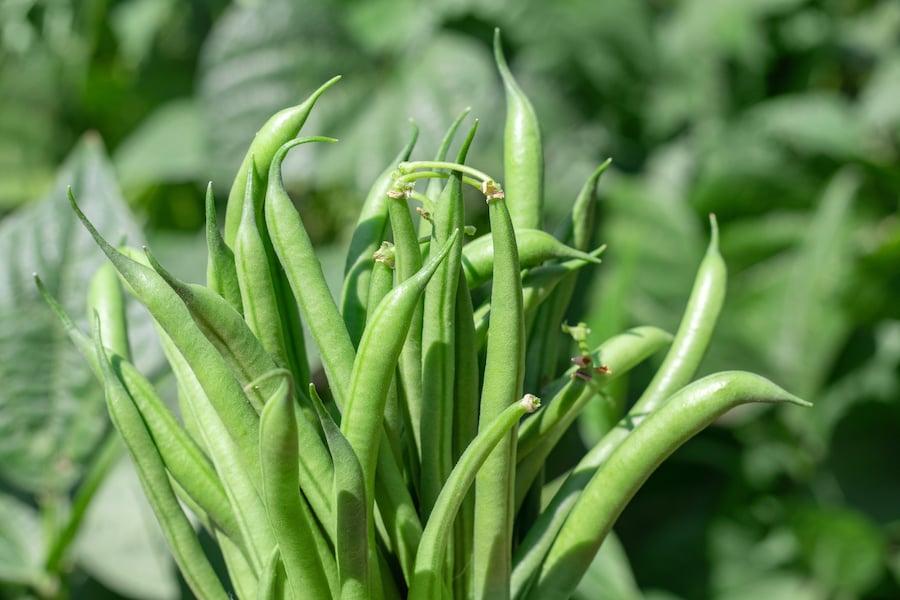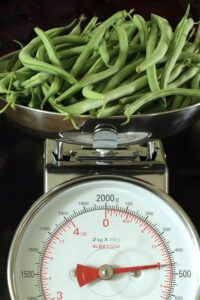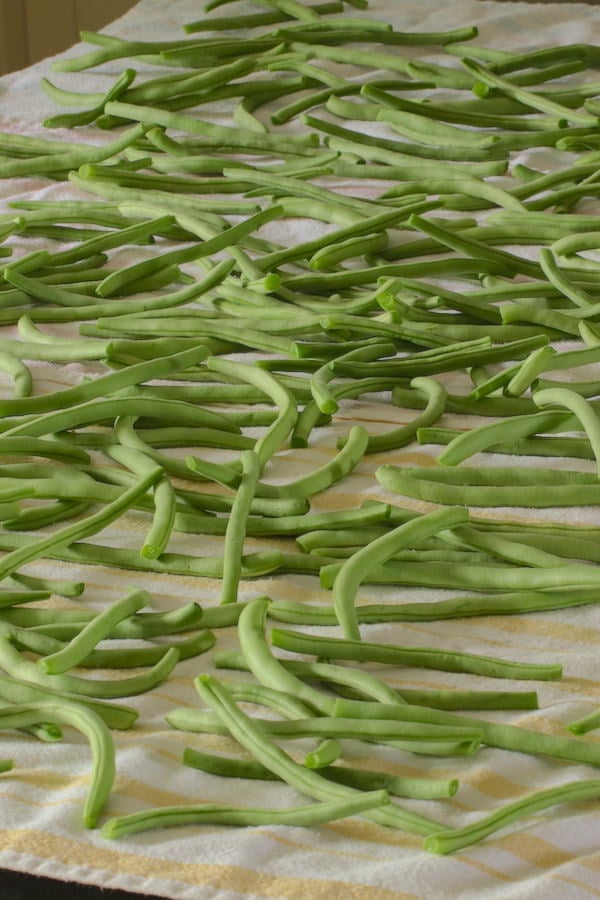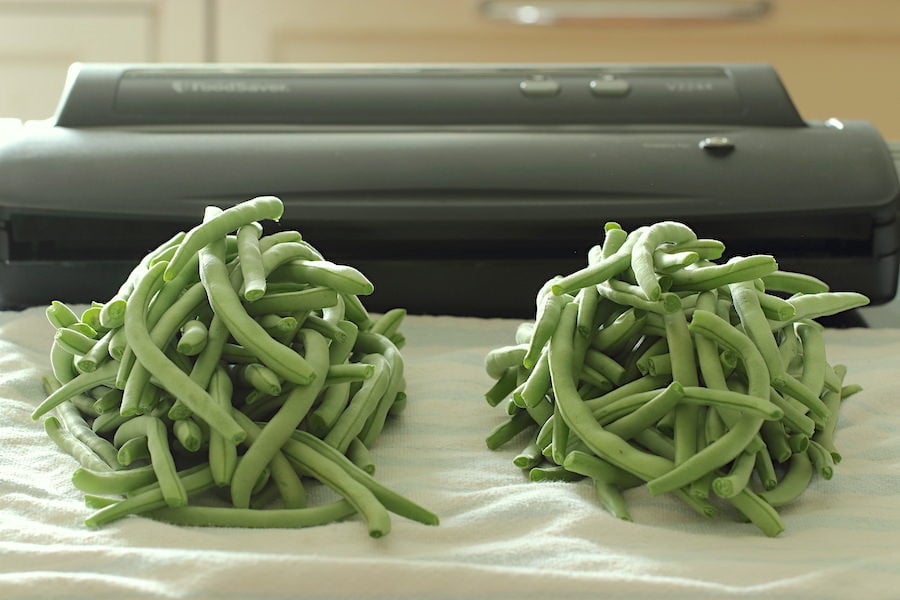This post explains how to freeze green beans without blanching them first. The process I use is very easy, especially if you have a vacuum sealer. No vacuum sealer? No problem! There’s an alternative method for sucking the air out of the bags with a straw.
Jamie tries to plant green beans twice each summer so there are plenty of fresh beans to enjoy in-season, plus enough to put up for the off-season. I can several jars of pickled beans with fresh dill each year. I also freeze several 1-pound packages to be enjoyed long after the gardens are put to rest.

This year’s first planting is a 20-foot row and it’s producing quite heavily right now. Jamie picked about two pounds last week and over two four pounds this week! We used a bunch to make my Dairy-Free Green Bean Casserole recipe (we all love it so much we prepared it twice in two weeks) and we’ve been adding them to other dishes as well.
I froze two pounds of beans today and took plenty of photos during the process to use for this tutorial.
As you probably gathered from the title of this post, I don’t bother blanching the beans before freezing. You may be wondering why I skip this step. The truth is, I’ve blanched beans before freezing them in the past – and I didn’t find that this extra step resulted in a better product. Just so you know, the National Center for Home Food Preservation (NCHFP) has a different opinion, and their official stance is quoted below.
Blanching (scalding vegetables in boiling water or steam for a short time) is a must for almost all vegetables to be frozen. It stops enzyme actions which can cause loss of flavor, color and texture. Blanching cleanses the surface of dirt and organisms, brightens the color and helps retard loss of vitamins. It also wilts or softens vegetables and makes them easier to pack.
National center for home food preservation
Rest assured that I’m not the only one that chooses to skip the blanching process. A quick google search will turn up several other posts on “how to freeze green beans without blanching” written by others that feel the same. Freezing without blanching poses no health risk so I feel comfortable going against the NCHFP’s suggestion in this regard.
I would never cut corners when canning though. I always follow lab tested and approved recipes, and would never take the risk of contaminating my canned goods in any way.
How to Freeze Green Beans without Blanching
Method Overview
- Snap, snip, or cut off the ends
- Cut or snap the green beans in halves or thirds if you desire (I usually leave them whole)
- Wash then drain in a colander; lay them out on towels to dry
- Portion and bag the green beans; remove the air and seal
- Label and date the bags, then freeze
Only freeze fresh and tender beans
For best results always start with fresh and tender beans. Trust me, freezing old and overgrown beans won’t improve their quality – it will only make them tougher. The best case scenario is to pick tender young beans, and freeze the same day.

How to prepare the green beans
The ends can snapped off, snipped off using a pair of kitchen shears, or they can be chopped off with a knife on a cutting board. Whether you choose to snap, snip, or chop – you can speed things along by lining up the ends and trimming several beans at a time. Discard any withered flower blossoms or other debris you find along the way. This will make the rinsing step easier.
I usually freeze the beans whole, but you can cut them (or snap them) into halves or thirds if you prefer.
What about the strings on string beans?
We never grow string beans. Who does that anymore? There are plenty of green bean varieties to choose from that don’t have tough strings to remove. If you do happen to have string beans – snap the blossom end and pull off the string in one motion, then trim off the other end.
Once the beans are ready, rinse them well and drain in a colander. Next lay them out on towels to dry. You don’t want to freeze wet beans because they’ll develop unwanted ice crystals.
A kitchen scale comes in handy for weighing the beans so you know how much you’re putting into each package. If you don’t have a scale, just eyeball it.

Freezing beans single layer
Alternatively you can freeze the beans single layer on trays before packaging them. I haven’t found this step to be necessary with green beans, but I know some people prefer to do it this way. If you do try this method, be sure to work quickly when bagging and sealing the frozen beans. The idea is to return them back to the freezer before they thaw.
I love having a vacuum sealer
The vacuum sealer I use is a Food Saver brand. It’s a no frills model V2244 and it cost about $45.00 four years ago. These gadgets last a long time; my first one lasted almost 15 years. Food Saver packaging rolls and bags are BPA free.
Why do I love vacuum sealers so much? Vacuum sealing the bags prevents freezer burn and ice crystals from forming. You retain more of the food’s flavor, texture, and nutrients when they are vacuum sealed.
Alternative method for sucking out the air
If you don’t have a vacuum sealer, use freezer zip-lock-style bags to freeze the beans. Squeeze out as much of the air from the bag with your hands as possible before zip locking. Then open just enough of the seal to slide in a straw. Suck out more of the remaining air through the straw and seal really well. If the bag isn’t sealed really well, air may slowly leak back into the bag causing ice crystals and freezer burn.
Stacking flat packages
Whether using a vacuum sealer or not, strive to create flat packages like in the photo above. This makes it easier to stack them in your freezer.
Temperature for freezing
Freeze your beans (or other products) quickly for best results. Your freezer temperature should be at 0º or lower. Arrange the packages single layer in the rear of your freezer if possible. Once frozen, it’s okay to stack the packages.
If you love green beans you should try my Green Beans and Okra with Dill recipe and also my Dairy-Free Green Bean Skillet Casserole. Another family favorite is the Green Beans Marinara recipe in my cookbook.





Very sensible and clear instructions.
Thanks from grandmother, daughter and granddaughters.
I like your way of doing things
🙂
You’re welcome! 3 generations putting up the garden! How nice 🙂
I love your recipes on how to can and freeze i have never canned any thing i have frozen stuff but my question is for pickling green beans can u use just the water and salt and vingar and not have to use the other ingredients like the dill seeds and pepper flakes and elc thank you
Hi Faye. I’m not sure which recipe you are referring to. Typically when following a pickling recipe meant for canning, it’s okay to omit herbs and spices. You can even omit the salt. But it isn’t okay to weaken the brine by adding more water. Strengthening the brine by adding more vinegar is okay though.
When canning, always use a recipe that’s been lab kitchen tested either through the National Center for Home Food Preservation, or a university extension service. Ball canning recipes are also safe.
This is the pickled green beans recipe I use https://nchfp.uga.edu/how/can_06/dilled_beans.html. It calls for a 50/50 brine of water and vinegar. However, I reduce the salt. It calls for 1/2 cup of pickling salt (way too much!!) and I use a Tablespoon of Himalayan sea salt instead.
When canning, it’s okay to change the type of vinegar as long as it is the same acidity and you don’t reduce the strength of the brine. For example, when making the NCHFP pickled beans recipe, instead of using 5% white vinegar, I use 5% apple cider vinegar (but still use a 50/50 brine).
Let me know if you haven any other questions,
Judy
I have a question. I just heard about freezing blanched peas and butterbeans in water. It was said that when thawed they taste as good as fresh picked. Have you heard of doing that with green beans? I am not a fan of frozen green beans (I dont like the taste) but would love to try something new. Thank You
Hi Darlene,
As I state in my post:
“I don’t bother blanching the beans before freezing. You may be wondering why I skip this step. The truth is, I’ve blanched beans before freezing them in the past – and I didn’t find that this extra step resulted in a better product. Just so you know, the National Center for Home Food Preservation (NCHFP) has a different opinion, and their official stance is quoted below.
I hope this helps!
Judy
The beans get mushy when you blanch the green beans.so it ok to just put the beans in the vacuum bags?
Hi Martha. That’s the point of this blog post.
Hi, how long do the beans typically last when frozen this way?
Thanks.
The general rule of thumb is that frozen vegetables are at their best for 6 to 8 months. They’ll be fine to eat after that but won’t be as nutritious.
If I vacuum pack my pole beans without blanching and freeze them, how do I prepare them when I take them out of the freezer?
Hi Mary. I prepare them the same way I’d use any frozen green bean. I love pole beans!
What is the best way to cook vacuum sealed and frozen green beans? Boil in the bags? Steamed? Any suggestions for length of time?
Hi Gail. I just cook them like I would any fresh or frozen beans